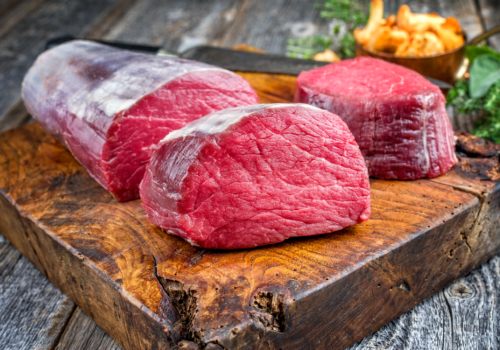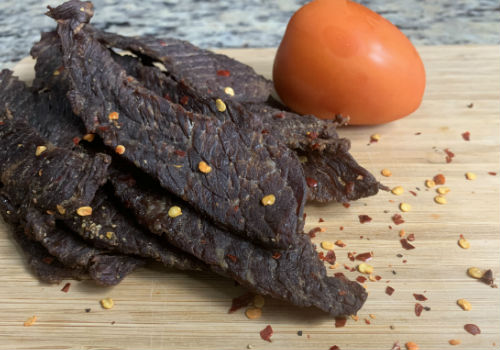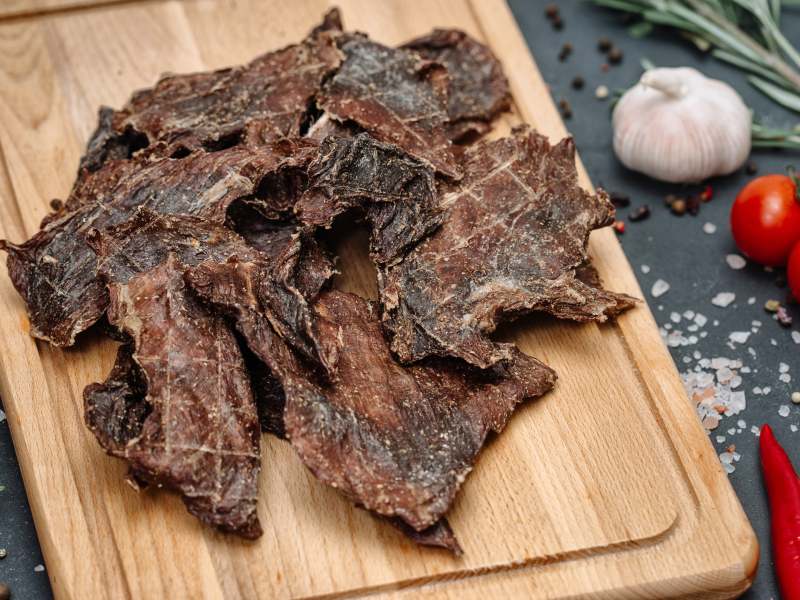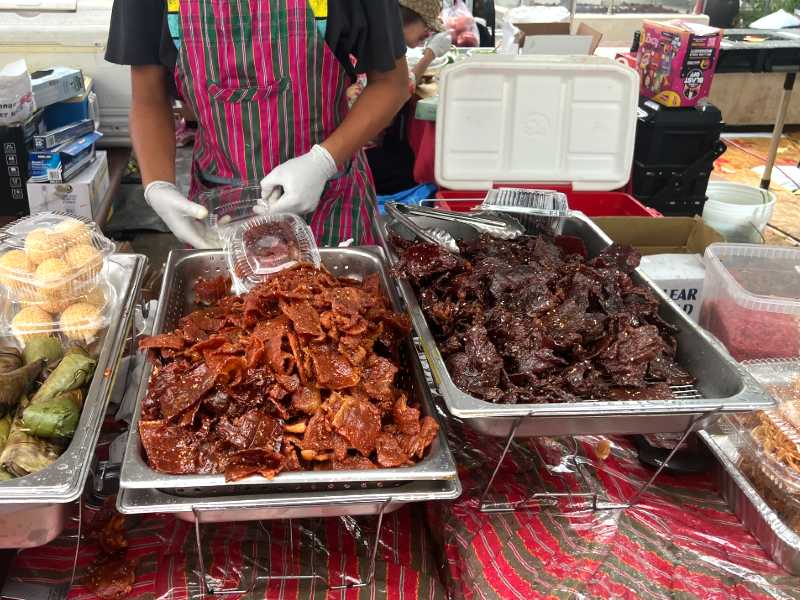If you’re looking to make beef jerky and you buy a pound of beef, you’d expect to get a pound of jerky, right?
Well, not exactly. The dehydration process involved in making jerky causes the meat to lose a good chunk of its weight.
So, just how much beef jerky will you get from a pound of meat?
What factors affect the final amount of jerky you get?
And what can you do to maximize the return on your beef jerky investment?
Read on to discover the science behind the beef-to-jerky ratio and optimize your jerky-making experience.
How Much Jerky Does a Pound of Beef Make?
When making beef jerky, the general rule of thumb is that you can expect your beef to lose between 50% and 65% of its weight during the dehydration process.
In other words, there’s an approximate 2:1 to 3:1 ratio of raw beef to finished jerky. One pound of beef will net you between ⅓ and ½ of a pound of jerky, and five pounds of beef will make 1.75 to 2.5 pounds of jerky.
Beef shrinks so much during dehydration because it’s about 60% water by weight, with leaner cuts being as much as 75% water. Dehydration, of course, removes the water from the meat, so most of that water weight literally evaporates into thin air.
What Factors Impact the Amount of Beef Jerky You Get?
You can use the 50% to 65% rule of thumb to get a ballpark idea of how much beef jerky you’re making.
But if you want to get more involved, you can impact your final weight by altering these factors.
The Cut of Beef You Use Impacts Your Final Amount of Jerky

Connect with Real Jerky Makers
Because the Best Jerky Doesn't Come from a Store
Let’s get molecular for a moment and look at the microscopic composition of beef.
Beef is primarily made up of water, protein, and fat. In addition to being present in the meat on its own, water is also a component of protein, so the more protein the meat contains, the higher the overall water content.
And as you may know from cooking, fat, and water don’t mix, so the fattier the cut, the less water it contains.
We tend to use leaner beef cuts when making jerky because fat causes the jerky to spoil faster. Because these lean cuts have less fat, the extra space is occupied by more protein and water, causing more weight loss during dehydration.
An Example of Moisture Loss During Dehydration
Let’s look at an example: eye of round, one of the most common cuts used in beef jerky. The USDA estimates that eye of round contains around 73% water.
Of that remaining 27%, around 23% is protein, 3% is fat, and 1% is other nutrients.
This is a great composition for beef jerky — there’s very little fat to trim before dehydrating, and that high protein content will make for a very nutritious jerky.
But extra moisture is added during marination, and the marinated beef is then dehydrated until it has around 20% moisture content. By the end of the process, the jerky will probably weigh around ⅓ of what the original beef weighed.
The Way You Dehydrate Impacts Your Final Amount of Beef Jerky
- EVEN HEAT DISTRIBUTION: 600 watts of drying power provides even heat distribution; consistent drying that is four times faster than other food dehydrators
- ADJUSTABLE TEMPERATURE CONTROL: The adjustable digital temperature control (90°F -160°F) gives you the flexibility to achieve the best results when drying different foods that need varying temperature settings
- EXPANDABLE TO 12 TRAYS: Comes with four (13 1/2″ diameter) trays and expands up to 12 trays so you can dry large quantities at once with no tray rotation needed; additional trays sold separately
- VITASAVE EXTERIOR: The opaque exterior blocks harmful light to retain more of the food’s nutrients and vitamins during the drying process
- ACCESSORIES INCLUDED: (2) Fruit Roll Sheets, (2) Clean-A-Screens, a sample of Jerky Seasoning & Cure, and a 52-page recipe & instruction book
Some people like their jerky crispy and dry as a bone, while others prefer it to be a little more chewy and moist. Your preference will impact how much jerky you get from a pound of beef.
The longer you dehydrate your jerky — and the higher the temperature you dehydrate it at — the more water will evaporate from the beef.
Most jerky recipes call for between 6 and 12 hours of dehydration between 140°, and 160° F. Those who like moist jerky may opt for a lower temperature and/or shorter time, resulting in a finished weight that’s closer to the original weight.
But if you leave your jerky in the dehydrator at a higher temperature or for a longer period of time, you’ll give the water in it more time to evaporate. Your finished jerky will be crispier and weigh less — but as a bonus, it will also be more nutrition-dense per ounce than moister jerky.
How Much Jerky Will You Get from Other Types of Meat?

Beef is far from the only type of meat you can use to make jerky. Turkey, salmon, buffalo, venison, tuna, and boar are just a few of the many types of meat that can be turned into delicious jerky.
While you can expect these meats to lose a good amount of water weight during dehydration as well, the exact amount will be different from that lost by beef.
That’s because these meats start out with different water/protein/fat compositions. Let’s take a quick look at a few of them and see just how much jerky they can make.
How Much Jerky Does a Pound of Turkey Make?
Turkey jerky is a popular choice for those trying to watch their saturated fat intake. A 1-ounce serving of turkey jerky contains no saturated fat, whereas 1 ounce of beef jerky can contain 15% or more of your daily saturated fat!
Most turkey jerky is made from turkey breast. It’s extremely lean, so there’s very little fat to trim.
Turkey breast is around 71% water, 23% protein, 2% fat, and 4% other nutrients. This makes it quite similar in composition to lean beef cuts like eye of round, so you can expect a similar jerky output: one pound of turkey breast will make around ⅓ of a pound of jerky.
How Much Jerky Does a Pound of Buffalo Make?
Buffalo or bison jerky has exploded in popularity for its low cholesterol, fat, and calorie content compared to beef jerky. It also has a slightly sweeter taste than beef, so marinades require less added sugar.
But buffalo meat tends to be slightly higher in moisture than beef: 74% water, 22% protein, 2% fat, and 2% other nutrients.
Therefore, you should expect to get less buffalo jerky per pound of raw meat than you would get with beef. One pound of buffalo might net you between ¼ and ⅓ of a pound of jerky.
How Much Jerky Does a Pound of Tuna Make?
Fish jerky, especially tuna jerky, is becoming more common. It’s rich in omega-3 fatty acids — up to 100 times richer, in fact, than beef jerky!
And tuna is nearly completely fat-free: less than 0.5% fat, with a minuscule 0.2% or less saturated fat.
Yellowfin tuna is often used for jerky for its chewy texture and lack of excessive fishy taste. Raw yellowfin tuna is around 74% moisture, 25% protein, 0.2% fat, and 0.8% other nutrients.
Remember that protein contains water, increasing the moisture content even further. Because tuna jerky has both more water and more protein than beef, even more weight will be lost during dehydration.
Thus, one pound of yellowfin tuna will make around ¼ of a pound of tuna jerky.
The Real Reason Beef Jerky Is so Expensive (Video)
"You might be a redneck if you think that beef jerky and moon pies are two of the major food groups."
-- Jeff Foxworthy







How much meat weight loss occurs?